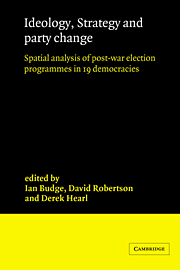 Ideology, Strategy and Party Change
Ideology, Strategy and Party Change Book contents
- Frontmatter
- Contents
- List of Tables
- List of Figures
- Preface
- 1 The influence of election programmes: Britain and Canada 1945–1979.
- 2 The internal analysis of election programmes.
- 3 Britain, Australia, New Zealand and the United States 1946–1981, an initial comparative analysis.
- 4 Canada 1945–1980: party platforms and campaign strategies.
- 5 Sri Lanka 1947–1977: elite programmes and mass politics.
- 6 Israel 1949–1981.
- 7 Ireland 1948–1981: issues, parties, strategies.
- 8 Northern Ireland 1921–1973: party manifestos and platforms.
- 9 Sweden and Denmark 1945–1982: election programmes in the Scandinavian setting.
- 10 The Netherlands 1946–1981.
- 11 Belgium 1946–1981.
- 12 Luxembourg 1945–1982: dimensions and strategies.
- 13 Austria 1945–1978.
- 14 Electoral programmes in West Germany 1949–1980: explorations in the nature of political controversy.
- 15 France 1958–1981: the strategy of joint government platforms.
- 16 Italy 1946–1979: ideological distances and party movements.
- 17 Japan 1960–1980: party programmes in elections.
- 18 Do parties differ, and how? Comparative discriminant and factor analyses.
- Appendices
- General bibliography
- Index
7 - Ireland 1948–1981: issues, parties, strategies.
Published online by Cambridge University Press: 27 October 2009
- Frontmatter
- Contents
- List of Tables
- List of Figures
- Preface
- 1 The influence of election programmes: Britain and Canada 1945–1979.
- 2 The internal analysis of election programmes.
- 3 Britain, Australia, New Zealand and the United States 1946–1981, an initial comparative analysis.
- 4 Canada 1945–1980: party platforms and campaign strategies.
- 5 Sri Lanka 1947–1977: elite programmes and mass politics.
- 6 Israel 1949–1981.
- 7 Ireland 1948–1981: issues, parties, strategies.
- 8 Northern Ireland 1921–1973: party manifestos and platforms.
- 9 Sweden and Denmark 1945–1982: election programmes in the Scandinavian setting.
- 10 The Netherlands 1946–1981.
- 11 Belgium 1946–1981.
- 12 Luxembourg 1945–1982: dimensions and strategies.
- 13 Austria 1945–1978.
- 14 Electoral programmes in West Germany 1949–1980: explorations in the nature of political controversy.
- 15 France 1958–1981: the strategy of joint government platforms.
- 16 Italy 1946–1979: ideological distances and party movements.
- 17 Japan 1960–1980: party programmes in elections.
- 18 Do parties differ, and how? Comparative discriminant and factor analyses.
- Appendices
- General bibliography
- Index
Summary
INTRODUCTION: ISSUE-DIMENSIONS AND PARTY SYSTEM
The primary purpose of this analysis is to identify the main issue dimensions in the post-war politics of the Irish Republic and to locate the positions of the three major parties – Fianna Fáil, Fine Gael and Labour – along these dimensions. The data used for the analysis are the programmes, manifestos and major election speeches of the three parties in the ten general elections held between 1948 and 1981. These were coded according to the schemes described in Chapter 2 and Appendix B, the only modification in the Irish case being the definition of the category Foreign Special Relationships: Negative as including statements in favour of the unification of Northern Ireland and the Republic.
Although no systematic analysis of the programmes and policies of Irish parties has been carried out prior to this present study, the existing literature is reasonably consistent in identifying some version of the nationalist cleavage as the major dimension of party competition, along with various secondary cleavages, e.g. ‘planned vs. market economy’ (Cohan 1982, p. 269), or ‘left vs. right’ and ‘town vs. country’ (Chubb 1971, pp. 58–60). Elsewhere, in a study based on the attitudes of party activists in a Dublin constituency, the dominant dimension has been identified as ‘pluralism vs. clericalism’, with ‘territorial nationalism’ as a secondary, but still very important dimension (Garvin 1977b).
- Type
- Chapter
- Information
- Ideology, Strategy and Party ChangeSpatial Analyses of Post-War Election Programmes in 19 Democracies, pp. 134 - 159Publisher: Cambridge University PressPrint publication year: 1987
- 3
- Cited by


